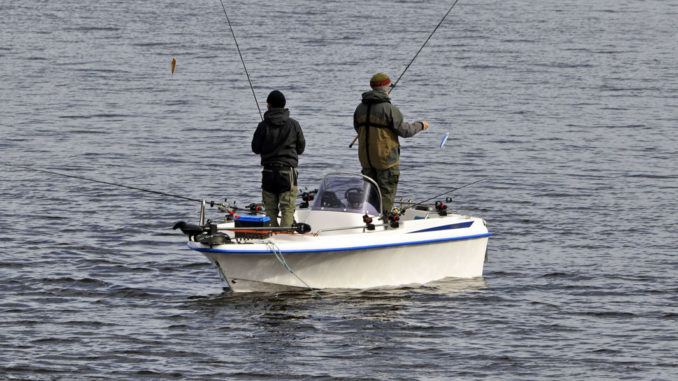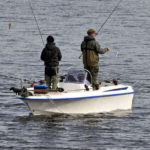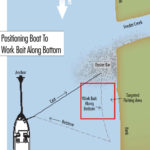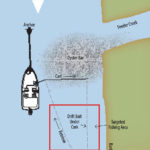
Current, how you want to fish are key factors
Some days when you fish, everything you do matters, and some days, it seems as if you couldn’t stop fish from biting if you wanted to. There is a lot of room for fishing mistakes between these two extremes, and being on the positive side more often is simply a matter of identifying bad choices from good ones and doing our best not to repeat the mistakes.
I believe the success of your next fishing trip begins while you’re cleaning up and organizing tackle after your most recent one. It is important to clean rods and reels, change leaders, tie on new lures and numerous other things in advance.
I believe fishing success begins as any approach any fishing spot. Fish may or may not be there, but the way you approach it sets everything up. If you are loud and noisy and spook the fish, you won’t catch them even with the best cast, best lure and a flawless retrieve.
Whenever possible, I approach from downcurrent or downwind, whichever is stronger. Sometimes you just can’t approach from downcurrent, but I have made wide sweeps through the marsh when fish were visibly feeding to approach them in a manner less likely to disturb them.
Noise does not travel upcurrent or upwind they way it goes downcurrent or downwind. This helps insulate the noise if you bump a push pole on the gunwale or scrape something on the bottom, and fish may give you a pass without spooking.
Approaching from downwind or downcurrent prevents you from drifting across your target if the anchor or Power-Pole doesn’t hold. This is more important in shallow water, but sometimes fish that have been pressured get spooky and nervous in deeper water, too.
I also don’t run the outboard motor once I get close to fish. Regardless of how quiet it seems above water, the exhaust is being directed through the propeller underwater, and there is noise. Sometimes it doesn’t seem to matter, but it’s a bad habit and will spook fish — usually at the most inopportune times.
I believe most fish can be approached within casting range while running an electric trolling motor that is in good condition, but if there are any knocks, rattles or squeaks, the fish may spook. Running the trolling motor too shallow and blowing water, or too deep and hitting the bottom with the spinning prop will definitely spook fish. I have friends who insist on poling once in water shallow enough to pole. It might be a little more caution than needed, but they don’t spook fish nearly as often.
If you are anchoring, don’t make a big splash with the anchor. Pick it and the chain up as quietly as possible and ease it over the side. The splash of an anchor may not run the fish away, but it will usually alarm them and often interrupt feeding for 15 to 30 minutes. Many trout holes are community holes, and there is room for multiple boats as long as everyone is courteous. Pulling up alongside or in the midst of boats that are fishing and chunking an anchor over doesn’t help the fishing and isn’t a way to make new friends. Subtle and quiet are key words to remember and practice.
Positioning the boat is important to working a spot. The first thing to understand is the current will move bait to or across a spot. You must position the boat to use the current to carry lures and baits across the spot as naturally as possible.
It is important to know whether current is caused by the tides pushing and pulling water or whether wind direction is more important. Depending on the strength of the current and wind, this occasionally creates situations where a bait suspended under a float will move in one direction, while a bait fished on the bottom may move another direction.
There are also areas with greater tidal variations where the tide begins moving back in along the bottom while the last of the falling tide is still flowing out along the surface. The basics of understanding how to use tides and current is pretty straightforward, but some of these nuances require a few years of hands-on experience to best comprehend.
Let me emphasize that I set up and fish a spot differently depending on whether I’m fishing the bottom or drifting a bait under a float. There is no doubt the positioning of the boat affects how the bait passes through a spot, and this can help produce bites and improve the hookup ratio.
When fishing the bottom, I approach my intended spot a little off to the side and on the downcurrent side. My cast is a little upcurrent to allow the lure or bait to get to the bottom by the time it drifts to my target area. With live or natural baits, I use enough weight to hold them on or very close to the bottom and let the swimming bait or current provide the action. With soft plastics, I use the lightest weight that will carry them to the bottom so the bait can flutter a lot as it sinks. The key to making soft baits attractive is to twitch them off the bottom a couple of inches and let them move at the same speed as the current. They will look a little dazed and easy to catch.
I have begun using a lot of weighted worm and swimbait hooks that put the weight near the middle of the bait. This allows the bait to sink on a level plane and not nose dive. I believe it adds to a bait’s action and definitely reduces hangups. I often fish this “weedless” by lightly tucking the point of the hook into the bait’s back. It won’t grab trash or structure, but as soon as a fish chomps down on it, the point pops free.
I fish suspending hard baits much the same as soft plastics. I like the excitement of catching fish on topwater lures, but the fish won’t always respond to them. My go-to hard baits are the suspending MirrOlure MirrOdine series. As long as the water is deep enough, suspending hard baits will drift above the bottom and not hang up. An occasional twitch to match the startled motion of any minnows you see is all that is needed. I cast them into the same places as the soft baits and let the current push them across or along the hole.
Sometimes the only way to fish an area is to drift a bait through it suspended under a cork, usually because of the potential for getting hung up on the bottom. This requires a different approach and boat placement to fish most effectively.
I approach these areas from downcurrent as far to the side as possible and either pole or use the trolling motor to creep past the spot, positioning the boat upcurrent and just off to the side. This is barely out of a straight line back to the spot and nowhere near as far out as when fishing the bottom. I don’t want as much line across the current when using a float, as it will sometimes drift faster or slower and pull the float out of the prime area. This approach will work with live baits, dead natural baits and soft plastics.
I prefer to fish an adjustable-depth float using a bobber-stop rig. It’s even more effective when I add a second bobber-stop under the cork so I can limit its downward travel and position it wherever I want to on the line to allow me to pop it occasionally to help attract fish. I also believe scent helps attract fish and slather up both soft and hard artificial baits. If it looks good, moves correctly and smells like something good to eat, it should get eaten.







Be the first to comment